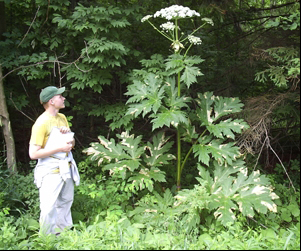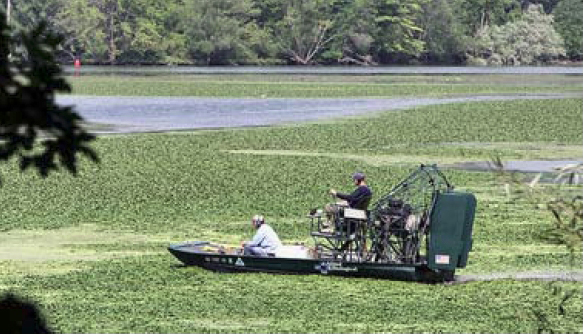Stony Brook, Ithaca, and Oswego, NY, July 13, 2011 - Giant hogweed. Asian carp. The bloody red shrimp. Just a few of the species that may, or already have, found their way into New York's ecosystems. New York Sea Grant and now Cornell Cooperative Extension Specialist Chuck O'Neill has kept tabs on these and other invasives for three decades now, currently through the New York Invasive Species Clearinghouse and its Web site, www.NYIS.info.
 O’Neill defines an invasive species as a species that is not native to the ecosystem of interest and is likely to cause harm to the economy, environment or human health in that area. He says Cornell University estimates that $120 billion is spent annually nationwide on aquatic and land invasive species programs. Giant hogweed, native to Eurasia, is just one of the land-based species addressed by such programs.
O’Neill defines an invasive species as a species that is not native to the ecosystem of interest and is likely to cause harm to the economy, environment or human health in that area. He says Cornell University estimates that $120 billion is spent annually nationwide on aquatic and land invasive species programs. Giant hogweed, native to Eurasia, is just one of the land-based species addressed by such programs.
Brought to the U.S. in the early 1900s, the tall plant blooms bunches of tiny white flowers the size of umbrellas, which made it a showpiece in ornamental gardens, including one in Rochester, N.Y. In the century since it was planted there, it has spread across the state, with 1,004 confirmed sightings so far this blooming season.
O'Neill cautions, "Hogweed is like 'Queen Anne's lace with an attitude.'" Specimens of the megaflora grow"more than 10 feet tall with two-inch thick stems, flowers two or more feet across and leaf clusters as wide as you can stretch your arms," O'Neill explains in NYSG's giant hogweed fact sheet (pdf).
Why all the concern? Hogweed is New York's most striking, dangerous and plant, and its sap "can make a case of poison ivy seem like a mild itch," says Naja Kraus, the New York State Department of Environmental Conservation's giant hogweed program coordinator. "If the sap gets on your skin and it's exposed to sunlight ... you end up with third-degree burns, oozing and scars. If it gets in your eyes, you can go blind."
The DEC urges people to phone the Giant Hogweed Hotline to report finding a specimen of the dangerous plant. They'll immediately dispatch a crew to dispose of it.
Now, O'Neill's efforts with New York Sea Grant and its partners have spread into other parts of our program, most recently in New York's 2011 Clean and Safe Boating campaign, developed and run by NYSG Coastal Recreation and Tourism Specialist Dave White.Marathon Boat Group has donated the use of a 16-foot, made-in-New-York Grumman Oneida fishing boat to be the 2011 Discover Clean & Safe Boating vessel. The boat is equipped with the gear required and recommended for boating on New York waters and provides boaters and anglers with information on how they can cope with and control the spread of aquatic invasive species.
"We are excited to be traveling through the Great Lakes region this year to talk with the diverse types of groups and individuals about clean and safe boating and the opportunity they have to make a positive impact on the spread of aquatic invasive species by following easy-to-implement practices,” says White.
In addition to angling and clean and safe boating, seminars offered during the campaign's tour stops around New York's Great Lakes region include discussions on slowing the further spread of invasive species, from Asian carp to zebra mussels.
"Aquatic invasive species can damage boat engines and steering equipment, reduce native game fish populations, degrade ecosystems, make lakes and rivers unusable by boaters and swimmers, and impact the economies of waterfront communities," says White.
One way in which boaters can help is through how they prepare and clean their recreational vehicles between uses. “People generally rinse off boats and trailers, but we need to be cleaning off everything that comes in contact with the water, from anchors and bait nets to fishing poles, fins and beach booties," says White. "Look closely at gear with nooks and crannies such as the lip of a kayak that can catch species such as zebra mussels and weeds.”
Another way New York Sea Grant is educating about aquatic invaders is through a new education program that launched last month. NYSG has hired two aquatic invasive species resource educators to informing anglers, watercraft enthusiasts, and local residents and visitors along the Lake Ontario and the Salmon River about how they can recognize and understanding the impact of those unwanted species on habitats, fisheries and the Great Lakes ecosystem.
“This new program gives people the opportunity to ask questions in the environment where they already have an interest and can make a difference in protecting the resource,” says NYSG's Coastal Community Development Specialist Mary Penney, who oversees the educators' public outreach efforts.
Just last weekend, NYSG's aquatic invasive species resource educators held a water chestnut pull Saturday in the Salmon River at Pine Grove state boat launch, Port Ontario.
“The establishment of water chestnut can result in large floating mats of vegetation that 'clog' aquatic habitats and limit the penetration of sunlight into the water column, impeding the growth of native plants and ultimately disrupting the food web,” says NYSG's Penney. Water chestnuts, native to Europe, Asia and Africa, were unintentionally released into the Charles River in the late 1800s. It was known to exist in the Great Lakes Basin by the late 1950s.
 An air boat from Allied Biological piloted by Steve Wilson sprays water chestnut growth along the Oswego River near Battle Island State Park last year.
An air boat from Allied Biological piloted by Steve Wilson sprays water chestnut growth along the Oswego River near Battle Island State Park last year.
Photo courtesy of David Lassman, The Syracuse Post-Standard.
“These non-native aquatic plant produces a large number of seeds, called nutlets, helping it to grow in colonies that rapidly multiply,” adds John DeHollander, director of the Oswego County Soil and Water Conservation District, a partner of NYSG in the invasive pull, along with Oswego County River Guides Association. “The lower Salmon River area at Port Ontario has been targeted for water chestnut control because the plant has not become fully established there.”
For more on this invasive aquatic plant, see NYSG's water chestnut fact sheet (pdf).
Additional information on water chestnut, giant hogweed and other invasive plant species can also be found on pages 3-4 of IFISHNY's June 2011 newsletter (pdf).
New York Sea Grant, now in its 40th year, is a statewide network of integrated research, education, and extension services promoting the coastal economic vitality, environmental sustainability and citizen awareness about the State's marine and Great Lakes resources. One of 32 university-based programs under the NOAA’s National Sea Grant College Program, NYSG is a cooperative program of the State University of New York and Cornell University.